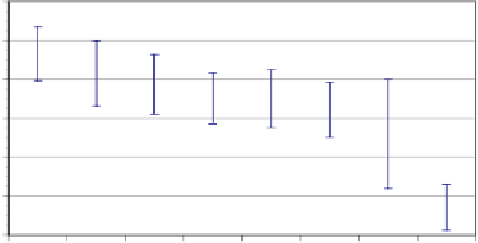Information Technology Reference
In-Depth Information
4400
4200
B
B
4000
B
B
B
B
3800
B
3600
3400
B
3200
Fig. 4.
Comparison of the eight agents in the TAC-05 finals, adjusted as in Table 2
8Con lu ion
Games as complex as TAC Travel generally present agent designers with a wealth
of policy choices, not amenable to analytic optimization. The typical recourse is to
experiment-guided search through a limited design space. We likewise follow such an
approach, but attempt to introduce some systematic game-theoretic reasoning to the
process. Our year-long search through the space of parametrized
Walverine
profiles
helped us to sort through 40 candidate strategies. Empirical game-theoretic analysis
justified pruning this set to a more manageable number we could test during the prelim-
inary rounds. This testing in turn proved valuable, as the leading contenders based on
tournament play appeared substantially better than some others surviving our testbed
analysis. In the end, our selected
Walverine
strategy performed ably in the 2005 tour-
nament, placing third officially and first after removing tainted games.
To further systematize the process, we require principled techniques for generating
parameter settings, and automating the selection of profiles to sample. This is the subject
of ongoing research, including continuing exploration of the space of strategies for the
TAC travel-shopping game.
Acknowledgments
Shih-Fen Cheng, Kevin O'Malley, and Julian Schvartzman have also contributed to
the 2005 version of
Walverine
and our simulation process. We thank the anonymous
reviewers for constructive comments. This work was supported in part by the National
Science Foundation under grants IIS-0205435 and IIS-0414710.
References
1. Cheng, S.F., Leung, E., Lochner, K.M., O'Malley, K., Reeves, D.M., Wellman, M.P.: Walver-
ine: A Walrasian trading agent. Decision Support Systems
39
(2005) 169-184
2. Wellman, M.P., Reeves, D.M., Lochner, K.M., Vorobeychik, Y.: Price prediction in a trading
agent competition. Journal of Artificial Intelligence Research
21
(2004) 19-36

